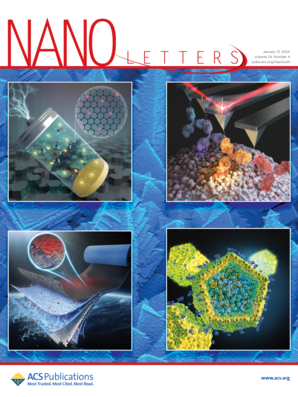Patterning on Living Tardigrades
IF 9.6
1区 材料科学
Q1 CHEMISTRY, MULTIDISCIPLINARY
引用次数: 0
Abstract
Micro/nanofabrication techniques have revolutionized modern photonics and electronics. However, conventional methods remain incompatible with living organisms due to inherent constraints including nonconformal coating, radiation damage, and toxic solvent requirements. Here, we present ice lithography for direct fabrication of micro/nanoscale patterns on the surfaces of tardigrades in their cryptobiotic state. Remarkably, upon rehydration the tardigrades revive, retaining the patterns on their surfaces. By precisely controlling parameters such as ice thickness, beam energy, and substrate properties, this method minimizes sample damage while achieving patterns as small as 72 nm. These patterns remain stable even after stretching, solvent immersion, rinsing, and drying. This approach provides new insights into tardigrades’ resilience and has potential applications in cryopreservation, biomedicine, and astrobiology. Furthermore, integrating micro/nanofabrication techniques with living organisms could catalyze advancements in biosensing, biomimetics, and living microrobotics.

现存缓步动物的模式
微/纳米制造技术已经彻底改变了现代光子学和电子学。然而,由于固有的限制,包括不合格的涂层、辐射损伤和有毒的溶剂要求,传统的方法仍然与生物体不相容。在这里,我们提出了冰光刻技术,用于在隐生状态的缓步动物表面直接制造微/纳米尺度的图案。值得注意的是,在补充水分后,缓步动物恢复了活力,保留了它们表面的图案。通过精确控制参数,如冰厚度、光束能量和衬底性质,该方法最大限度地减少样品损伤,同时实现小至72纳米的图案。即使经过拉伸、溶剂浸泡、冲洗和干燥,这些图案仍然保持稳定。该方法为缓步动物的恢复能力提供了新的见解,并在低温保存、生物医学和天体生物学方面具有潜在的应用前景。此外,将微/纳米制造技术与生物体相结合可以促进生物传感、仿生学和活体微型机器人的发展。
本文章由计算机程序翻译,如有差异,请以英文原文为准。
求助全文
约1分钟内获得全文
求助全文
来源期刊

Nano Letters
工程技术-材料科学:综合
CiteScore
16.80
自引率
2.80%
发文量
1182
审稿时长
1.4 months
期刊介绍:
Nano Letters serves as a dynamic platform for promptly disseminating original results in fundamental, applied, and emerging research across all facets of nanoscience and nanotechnology. A pivotal criterion for inclusion within Nano Letters is the convergence of at least two different areas or disciplines, ensuring a rich interdisciplinary scope. The journal is dedicated to fostering exploration in diverse areas, including:
- Experimental and theoretical findings on physical, chemical, and biological phenomena at the nanoscale
- Synthesis, characterization, and processing of organic, inorganic, polymer, and hybrid nanomaterials through physical, chemical, and biological methodologies
- Modeling and simulation of synthetic, assembly, and interaction processes
- Realization of integrated nanostructures and nano-engineered devices exhibiting advanced performance
- Applications of nanoscale materials in living and environmental systems
Nano Letters is committed to advancing and showcasing groundbreaking research that intersects various domains, fostering innovation and collaboration in the ever-evolving field of nanoscience and nanotechnology.
 求助内容:
求助内容: 应助结果提醒方式:
应助结果提醒方式:


